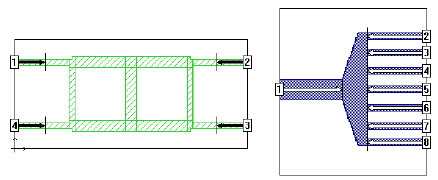Sometimes, your circuit may contain multiple parallel feedlines as shown in the circuits below:

There are two issues in the above examples:
Both of these issues are resolved by using “shared” reference planes. When the reference planes are set to “shared,” coupled lines are used for calibration standards, thus removing the coupling between the ports and the feedlines. The alternative to shared reference planes is “independent” reference planes. The table below summarizes which types of reference planes, shared or independent, are used for which type of ports:
Port Type |
Reference Plane Type |
Box-wall (orthogonal) with reference plane |
Shared or Independent (Determined by user) |
Box-wall (diagonal) |
Independent only |
Co-calibrated (orthogonal using Sonnet Box Ground) |
Shared only |
Co-calibrated (diagonal using Sonnet Box Ground) |
Independent only |
Co-calibrated (Floating Ground) |
None |
Delta Gap |
None |
Via Port |
None |
The topics below discuss the implications of using shared or independent reference planes.